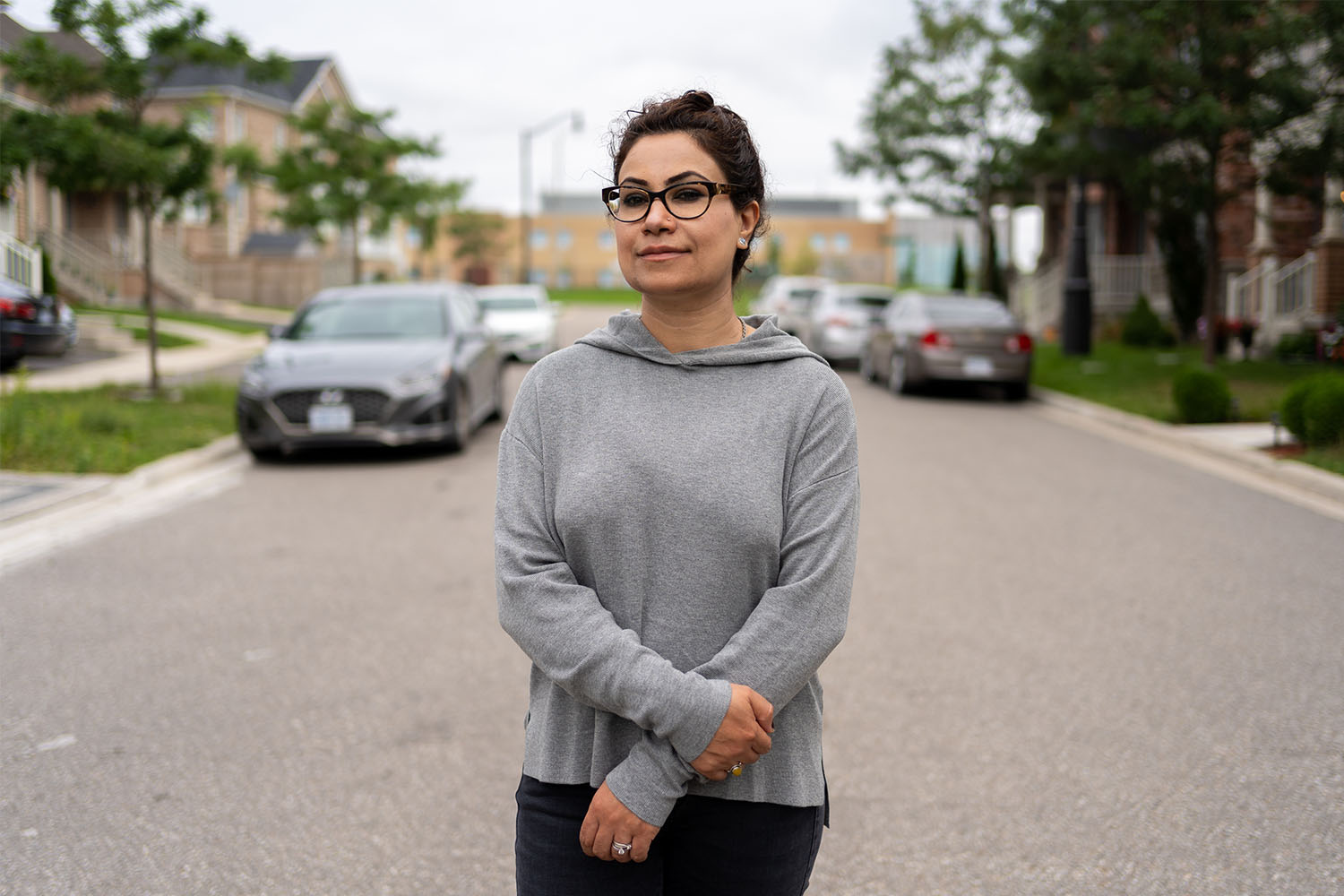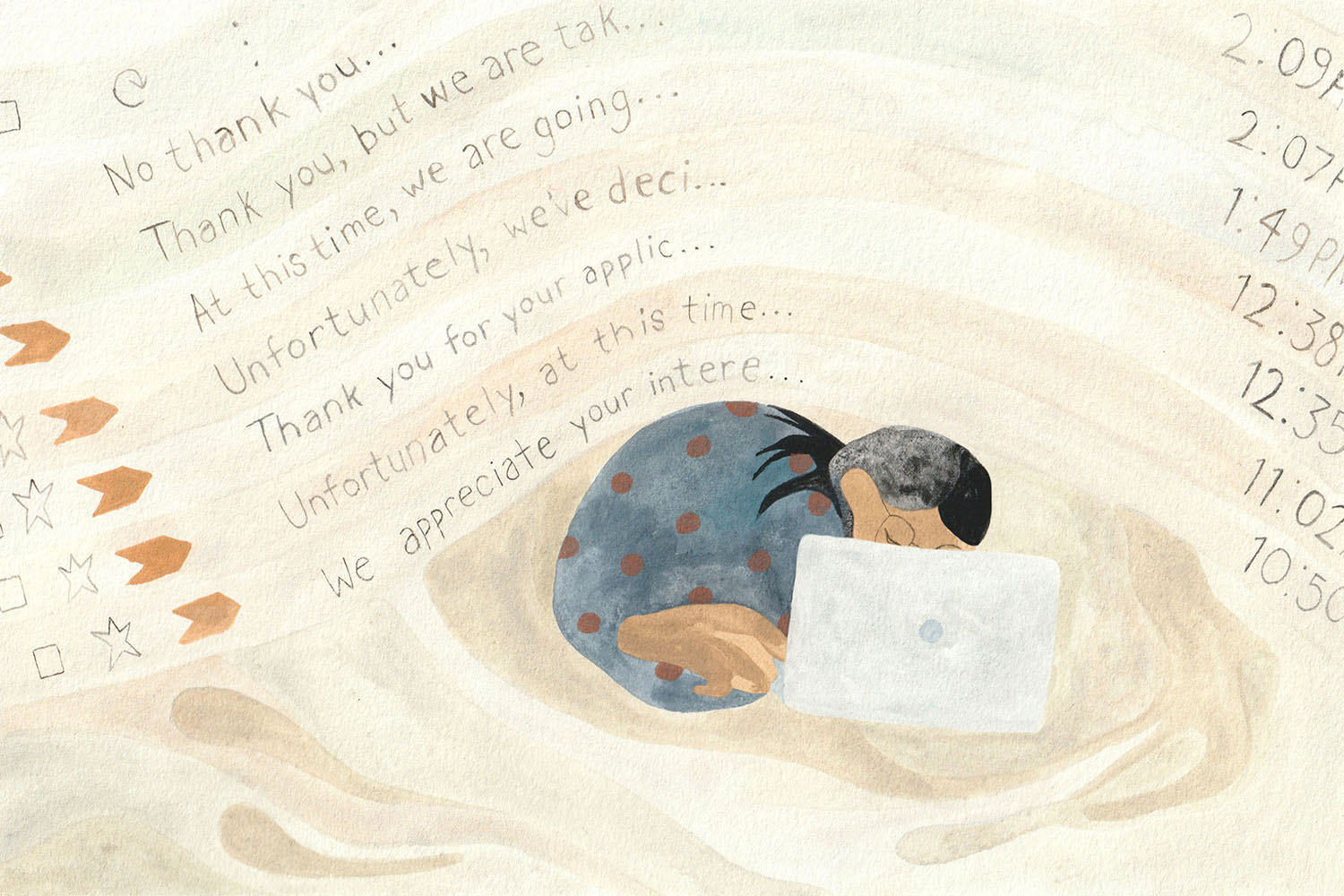

For a few years before the pandemic, Tanya d’Anger held a teaching job that required her to work more or less every hour she was awake, from 6:00 in the morning to 11:00 at night.
As a part-time community college instructor teaching English and communication courses at Humber College and Centennial College in Toronto, she would shuttle between campuses on either side of town, getting home by 7:00 p.m. and then continuing to work sporadically until she fell asleep. Her workload overflowed into her weekends. There were no holidays.
Where a full-time college instructor might teach three or four courses per semester, d’Anger was teaching nine. It was her way to avoid being short-changed as each new semester rolled around. As a part-time faculty member, d’Anger wasn’t guaranteed any work. Colleges can reduce workloads without warning, even denying instructors classes they have taught for years. Requesting too many courses was d’Anger’s way of hedging against the disaster of being denied any work at all.
As a result, days would go by without a shared family meal. “My 12-year-old daughter… would be the one to pick up my son from school because I didn’t know if I’d be home until 8:00,” she says. “We didn’t have any other options.”
Her health suffered. She had little time to eat well and her diet deteriorated. Alcohol became an occasional coping mechanism at the end of a gruelling day and she developed severe back problems. “I was in so much pain I could barely stand upright in the classroom,” she remembers.
Somehow, all that work still wasn’t enough. Over 11 years of teaching, d’Anger went from having no debt at all to having more than she could pay off, partly due to childcare costs when her children were young. Eventually she bundled her debt into her house, doubling her mortgage.
D’Anger, a woman with a doctorate and over 15 years of teaching experience, was working in what she describes as “survival mode,” a relentless pursuit of financial stability at the expense of her own physical and mental wellbeing. Two years ago, she got into a car accident because she was “unbelievably burnt out” on that day’s commute. She’s still paying off the debt for the repairs.
“This isn’t sustainable,” d’Anger says. “None of it’s sustainable. You just do it because you’re trapped in this system unless you walk away from it.”

D’Anger’s is just one story of precarity in a college teaching environment packed with overworked and underpaid professionals. At Toronto’s four public colleges—George Brown, Sheridan, Humber, and Centennial—contract faculty consistently face chronic job instability and lower wages than their full-time counterparts. Contract faculty say that they can make as little as one-third of what full-time instructors make. One’s level of education and seniority offer little protection from the teaching racket; one faculty member described seeing a colleague of retirement age proudly display the business cards from the multiple colleges he taught at to make ends meet.
Meanwhile, colleges are booming. From 2011 to 2019, Seneca College’s enrollment figures grew from 20,000 to 30,000 full-time students. New campuses were built in downtown Toronto and outside Peterborough, and extensions were built at pre-existing campuses. Colleges have used growing tuition revenues to transform their image, adding new programs in growing sectors like social media marketing and video game design while rebranding themselves as the superior alternative to universities for young, energetic go-getters.
In the background, contract faculty were hired to teach these programs as the cheaper option to full-time professors. Data from the StatsCan Labour Force Survey, shared with The Local upon request, shows a clear increase in the proportion of post-secondary instructors working part-time, from 23 percent to 38 percent from 1998–2020. In comparison, the average proportion of part-time workers across all other industries was 10 percent in 2020. In 2014, there were three contract faculty for every full-time hire. Over the next five years, the number of contract faculty grew by 7.2 percent, while the number of full-time faculty grew by just 1.8 percent.
In the most recent report on Ontario colleges from the Ontario Public Service Employees Union (OPSEU), released in September, researchers from Niagara College and Mohawk College attribute the growth of cheap contract faculty to declining government funding. “To make up for the lack of full-time faculty, colleges are increasingly relying on a precarious, flexible, casual workforce that is cheaper to employ and easier to dispose of at will,” they write. Contract teachers were indispensable to the college’s transformations, but there were no full-time jobs waiting on the other side. Once contract teachers were in the system, they were stuck.
Postsecondary educators are not usually considered precarious workers. Being a professor seems like a privileged and well-paid profession, but part-time teaching is a completely different world.
Generous salaries are only found for tenured academics in the university system, says Louise Birdsell Bauer, a sociologist who’s spent years researching the divide between contract and full-time faculty.
“Generally there’s been a correlation between the wealthiest people in our society and the professoriate, but contract faculty are a different story,” she says.
“In colleges, you’re not necessarily talking about PhDs,” says Jeff Brown, a full-time faculty member at George Brown and executive with his local labour union for contract faculty. “You’re talking about working professionals who are trying to contribute as educators, but they’re also trying to stitch together a living.”
Contractual teaching in a college is far closer to gig-work than to a cushy tenured professorship with research sabbaticals. Instructors are only contracted for a single semester, so faculty who “ride the circuit” go from college to college combining short-term contracts to make a living. They might spend three months teaching two courses each at Centennial and Seneca, then land four courses at Humber the next semester.
Without stability, instructors are dependent on benevolent department chairs to offer them the same contracts year after year, but colleges are under no inherent obligation to retain contract faculty members once their contracts are up.
Contract faculty are paid substantially less than their full-time colleagues. At Humber, D’Anger is paid $123 an hour, a generous fee on the surface. But contract instructors are only paid for the time spent in a classroom teaching. After tallying all the time preparing for lectures, sitting in office hours, and marking hundreds of essays and quizzes, her effective hourly rate is far lower.
Colleges also don’t give contract faculty much notice before their contracts begin—sometimes as little as a weekend—which means long periods of financial uncertainty. Maryam, a contract faculty member who spoke to The Local under a pseudonym due to fear of professional reprisal, said this makes family planning difficult for her and her husband. Her paycheque looks “drastically different” from summer to summer. And because her family can’t survive on her husband’s income alone, she ends up “double gigging” herself at multiple colleges to make up the difference.
Many contract faculty dream of full-time positions, but there’s no guarantee they will ever receive one. D’Anger says she’s interviewed for full-time positions three times, with no success. She calls the experience “debilitating,” and says she’s given up because the system feels broken. “They want my experience,” she says, “but [I’m] kept as a second-class citizen to avoid the cost of hiring a [full-time employee].”
Anna Ainsworth, a full-time professor at Seneca College, says many of her contracted colleagues express gratitude for having a job at all. “I feel the need to be like, ‘No, you should not be grateful. This institution cannot exist without your labour.’ ”
Ainsworth studies trauma in political violence, and says her profession reminds her eerily of her research. “I do not use the word ‘trauma’ lightly. I use it concretely to describe specific psychological symptoms” says Ainsworth.
“It’s a persistent, consistent level of anxiety, because even when you have that contract, you don’t know what’s going to happen three to four months later.”
Contractual teaching in a college is far closer to gig-work than to a cushy tenured professorship with research sabbaticals
Contract faculty do have a voice, in the form of OPSEU, which represents contract faculty in clashes over wages and work.
However, OPSEU’s agreement with the colleges doesn’t allow them to represent all contract faculty. Only faculty who teach between seven and twelve hours a week are allowed to be unionized. If you’re outside that narrow range, you’re outside the union.
OPSEU executives are not entirely certain how their bizarre membership structure originated, but Jonathan Singer, a full-time professor at Seneca College and an executive with his local OPSEU branch, believes the initial reason for this narrow band of inclusion was a report in the 1980s which suggested faculty working those hours tended to be women. “I think it was a gesture towards employment equity to take that tranche and place it within the union,” he says.
Faculty teaching different hours may have been excluded from the union because, at the time, legislators didn’t think those instructors would ever be relying solely on teaching income. Those teaching over 12 hours a week were either testing a new program before a college was willing to commit to a full-time hire or replacing an employee on maternity leave. Those teaching fewer than seven hours were assumed to be working professionals—seasoned veterans still in the workforce who could spare a few hours to share their experience with young minds.
But over the decades, as contract faculty members have come to rely on these part-time contracts as their primary source of income, the rationale of the system has fallen out of touch with reality.
“It’s an ancient, industrialized kind of model,” says Bob Bolf, a business professor at Humber. “Our environment has…changed since then, but we’re still stuck in that old structure.”
Whatever the origin, the result is a bizarre patchwork in which some contract faculty are unionized, with access to higher wages, benefits, and union representation to settle grievances, while thousands of their colleagues are left out in the cold.
Margaret, a former contract faculty member who spoke to The Local using a pseudonym for fear of professional reprisal, left teaching in 2018 when she discovered she was being kept out of the union. She was hired at Humber College for a contract of less than seven hours a week.
Unsatisfied with her pay, she went to OPSEU for advice. They informed her that the college was keeping her just one or two hours shy of the “partial load” category—another name for faculty in the union. Had she been an OPSEU member, her pay would have been higher.
Margaret quit soon after. In total, she worked at Humber for three weeks. It was only after she quit that she received an email acknowledging she should have been paid more. Aside from sporadic substitute teaching, that was her last stint at a college.
Contract faculty who teach at multiple colleges have a slightly different experience. Depending on their hours, they can simultaneously be in and out of the union. They may have union privileges, but are only able to use them at the college where they apply.
D’Anger is in this position most semesters. She is usually unionized at Humber and non-unionized at Centennial. Drawing on her doctorate in drama, d’Anger says she feels like Janus, the Roman god with two faces on either side of his head. “I’m in this ridiculous situation where I’m in the union when on one side of my face, and out of the union on the other side of my face,” she says.
To the Romans, Janus presided over any situation with two opposing elements: crossroads, contradictions, and changes in the arc of one’s life. It’s an apt metaphor for professionals who walk a tightrope through so many dualities, leaning this way or that with each shift of contract and college. Momentarily stable, then precarious. Anxiety and then ease. Balanced for now. In freefall.
All these cracks in the system, steadily growing for years, were finally torn open in 2016 and 2017, when OPSEU staged two consecutive strikes for better pay and job security. During the 2017 strike, all 12,000 partial load faculty and many of the 20,000 non-unionized faculty refused to go to work. All four public colleges in Toronto cancelled full-time classes. For five weeks—the longest strike in OPSEU’s history—more than 500,000 students across the province had their education disrupted.
In the wake of the strike, OPSEU was able to successfully push for small changes. One of their victories was a registry where faculty can list which courses they have typically taught in the past—a small, if non-binding, step towards a seniority-based system. They’ve also made sure that colleges do not abuse the contract system: if a teaching position is filled by a contract faculty member for a long time, the union can file a grievance to encourage the college to make the position full-time.
But the strikes failed to change one thing: union organizers can still only offer these services to its members. “In terms of solidarity or collegiality, I never turn anyone away,” says Jeff Brown. But when non-unionized faculty come to him for aid, the only thing he can offer is advice. “Past the commiserating and the empathizing, there’s usually nothing [I can do].”
“You have an entire group of faculty who aren’t even formally represented in any way and basically have no rights,” he adds.
Non-unionized faculty have tried to fight back. In the summer of 2016, approximately 20,000 non-unionized faculty across the province voted to join OPSEU. According to the union, the results were overwhelmingly positive: 84 percent of respondents said yes.
But the votes were never fully counted and ratified. Five years later, they still aren’t.
Contract faculty both inside and out of the union, including OPSEU executives, claim that the College Education Council, the body that represents all the colleges in collective bargaining, has been stalling the vote count for years. R.M. Kennedy, chair of OPSEU’s faculty division, says that the Council’s list of employees was “rife with errors” and “left out thousands of employees we know should be there,” which has drawn out the process. As a result, OPSEU has been forced to examine each name individually.
In a statement to The Local, the CEO of the Council, Graham Lloyd, denied any wrongdoing. “We can assure you that we are not delaying or refusing to count votes cast by the proper representatives,” Lloyd wrote.
“It is indeed a complex process and we have no doubt the union will agree as it initially filed more than 8,500 objections questioning who should be included as a part-time employee, to which the Colleges are required to respond to each and every objection individually. Therefore, we cannot accept that we are refusing or delaying to count votes.”
“You have an entire group of faculty who aren’t even formally represented in any way and basically have no rights”
For d’Anger, the 2017 strike was a revelation. As her colleagues left their classrooms and marched as one across Ontario, something became clear to her.
She didn’t deserve this. She didn’t deserve the long hours and unfair pay—she deserved a fair wage, time off, and a work environment that made her feel seen.
Her colleagues seemed scared to speak to the press. So she started doing it for all of them.
“It’s like a switch went on, and I suddenly wasn’t going to be bullied anymore,” she says.
The 2017 strike ended with a back-to-work order from the provincial government. Faculty say many of the issues remain unaddressed. The workloads are still unsustainable. There’s still a shortage of full-time positions, forcing many contract faculty to keep stringing together contracts. And until the vote count is settled, tens of thousands of educators are barred from the union. OPSEU and the Council are currently negotiating a renewal of their agreement, which expired at the end of September. As of publication time, no agreement has been declared. If an agreement cannot be reached, yet another strike may be called.
D’Anger sees the lack of progress, but she tries not to let it get to her. Since the strike, she’s decided she’s done with “survival mode.”
Over the summer, teaching fewer classes online without a commute, she finally had time for herself. She swam every day and her back pain immediately became manageable. “I was suddenly able to sleep enough at night,” she says. “I hadn’t realized how much that was affecting my health.”
She had time for her family again. She sat down with her son for every meal, finally getting the chance to talk and bond. She felt both physically and psychologically stronger, full of a youthful energy she thought she’d lost.
But the fall semester changed things suddenly. D’Anger took on more courses, and the stress returned just as swiftly as it had vanished. She doesn’t have time to swim anymore, and the back pain is back. When it flares up, she can barely climb the stairs in her home. She no longer sleeps well.
D’Anger’s mentality isn’t the problem, her situation is. Today, she still ensures that she’s eating dinner with her son everyday. She fights to make time for herself in between Zoom lessons. But her precarity doesn’t give her the freedom to live the life she wants. She is still walking the line between wellbeing and burn out, with no clear end in sight.










